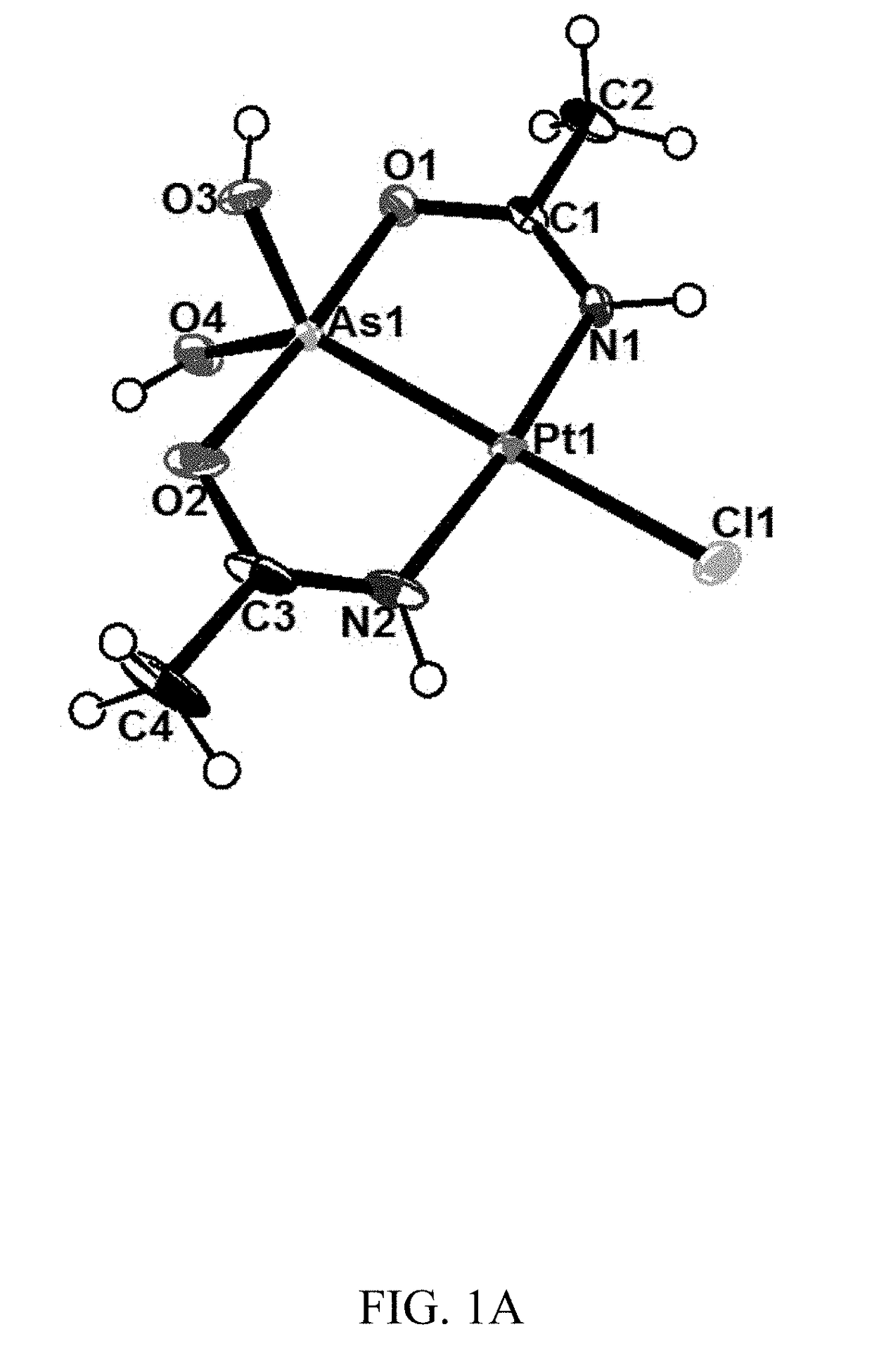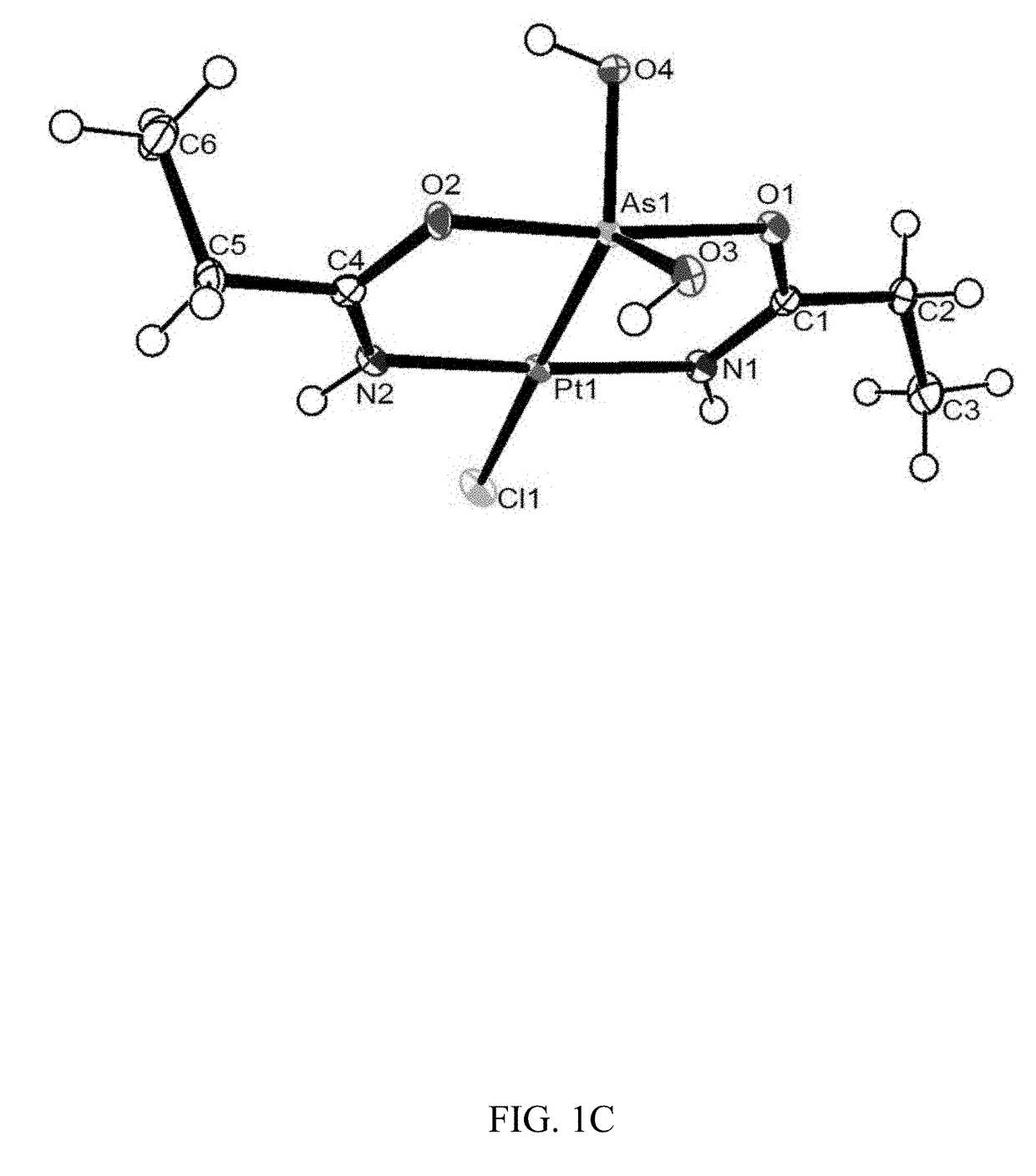Arsenoplatin Anti-cancer agents
- Summary
- Abstract
- Description
- Claims
- Application Information
AI Technical Summary
Benefits of technology
Problems solved by technology
Method used
Image
Examples
example 1
ethods
[0177]Cisplatin, K2[PtCl4], DMSO, methanol, acetonitrile, propionitrile and As2O3 were purchased from Sigma-Aldrich and used without further purification. Media for the cell cultures and all other cell supplements were purchased from Invitrogen. The following spectrometers were used: NMR: Bruker Avance-III 600 and 500 MHz; chemical shifts (1H, 13C) were referenced to tetramethylsilane at 0.000 ppm 1H and 13C if it was present, and to residual solvent signal for samples in which TMS was absent (for [D6]DMSO, δH=2.50 ppm and δC=39.5 ppm). The 195Pt (129 MHz) and 15N (61 MHz) NMR spectra were acquired on a 600 MHz Bruker Avance III spectrometer equipped with BBO (broadband observe) probe. 195Pt NMR chemical shifts were referenced indirectly to TMS in 1H NMR spectrum such that Na2 195PtCl6 in D2O would resonate at 0.0 ppm. 15N NMR chemical shifts, both those observed directly in 15N-detect 1D experiments and 2D 1H-15N HSQC experiments, were referenced indirectly to TMS in the 1H s...
example 21
raphic Structure Determination and Refinement Details
[0200]Colorless crystals of compounds (1), (2) and (5) were mounted using oil (Infineum V8512) on a glass fiber. All measurements were made on a Bruker APEX-II CCD area detector with graphite monochromated MoK\α radiation. The data were collected at a temperature of 100(2) K (1a, 2, and 3) and 111(2) K (1b), and integrated and corrected for decay and Lp effects using Bruker APEX II software. Final unit cell parameters were obtained through a refinement of all observed reflections during data integration. A face-indexed absorption correction was performed via XPREP. The structures were solved and refined using the SHELXTL suite of software. In the structure of compound (1) (crystal form 1a) the non-hydrogen atoms were refined anisotropically. There is an acetamide and water disordered over the inversion center. The hydrogen atoms on the water were not found in the difference map. The C8 atom (in 1a) and N1 (in 3) were restrained wi...
example 22
re Conditions and In Vitro Cytotoxicity Assay
A. Cell Culture Conditions.
[0206]The MDA-MB-231-mCherry breast cancer cells were cultured in Dulbecco's modified Eagle's medium (DMEM) and supplemented with 5% heat-inactivated fetal bovine serum (FBS), 50 units / ml penicillin, 50 μg / ml streptomycin, 2 mM L-glutamine, and 1 μg / ml blasticidin S (Sigma). The A2780 and A2780CP ovarian cancer cell lines and the multiple myeloma RPMI 8226 cell line were cultured in RPMI 1640 medium supplemented with 10% FBS, 50 units / ml penicillin, 50 μg / ml streptomycin, 2 mM L-glutamine. The U-87 and HTC-116 cancer cell lines were cultured without antibiotics. Cells were grown at 37° C. in a humidified atmosphere of 5% of CO2.
B. In Vitro Cytotoxicity Assay for MDA-MB-231mCherry, A270 and A2780CP Cancer Cell Lines.
[0207]The cytotoxicities of compound (1), cisplatin, and As2O3 were assessed by MTS assay using the CellTiter 96 Aqueous MTS (Promega). The 100 μL aliquots of cell suspension (1.0×105 cells / ml) were p...
PUM
| Property | Measurement | Unit |
|---|---|---|
| temperature | aaaaa | aaaaa |
| yield | aaaaa | aaaaa |
| mass | aaaaa | aaaaa |
Abstract
Description
Claims
Application Information
 Login to View More
Login to View More - R&D
- Intellectual Property
- Life Sciences
- Materials
- Tech Scout
- Unparalleled Data Quality
- Higher Quality Content
- 60% Fewer Hallucinations
Browse by: Latest US Patents, China's latest patents, Technical Efficacy Thesaurus, Application Domain, Technology Topic, Popular Technical Reports.
© 2025 PatSnap. All rights reserved.Legal|Privacy policy|Modern Slavery Act Transparency Statement|Sitemap|About US| Contact US: help@patsnap.com



